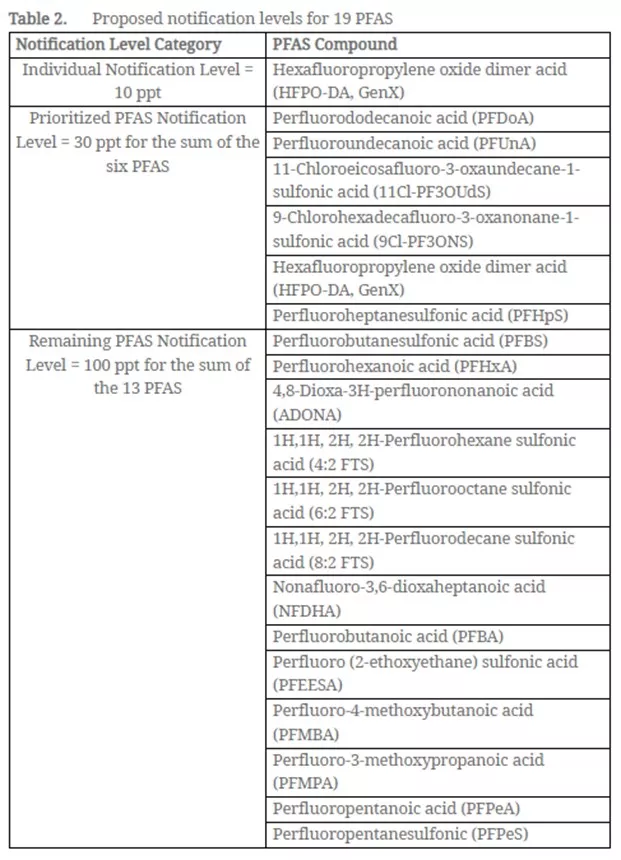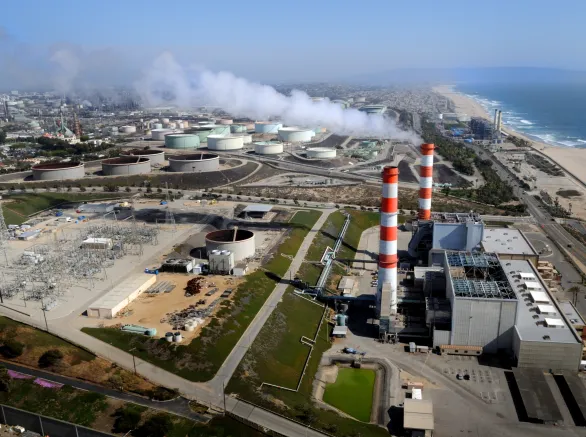October 14, 2022
Twenty-three per- and polyfluoroalkyl substances are targeted for expanded analysis
On October 5, the New York State Department of Health issued a notice of proposed rulemaking regarding certain per- and polyfluoroalkyl substances (PFAS) in drinking water. The proposed rule seeks to establish new maximum contaminant levels (MCLs) for four PFAS compounds and notification levels (NLs) for 19 PFAS compounds. These proposed changes will impose new sampling, reporting, and potential treatment requirements for public and private water suppliers throughout the state.
For public water supplies serving more than 3,300 people, initial monitoring of each source would be required on a quarterly basis for one full year.
New maximum contaminant levels
In 2020, New York established MCLs for two PFAS compounds, perfluorooctane sulfonic acid (PFOS) and perfluorooctanoic acid (PFOA), both with enforceable drinking water limits of 10 parts per trillion (ppt). The new proposed rulemaking seeks to establish enforceable MCLs of 10 ppt for four more PFAS compounds: perfluorohexanoic acid (PFHxS), perfluoroheptanoic acid (PFHpA), perfluorononanoic acid (PFNA), and perfluorodecanoic acid (PFDA) (Table 1).
In addition to the proposed MCLs for individual PFAS, the proposed rule also seeks to establish a combined MCL of 30 ppt for the sum of all six compounds, collectively known at "PFAS6." The proposed rule seeks to make monitoring, reporting, and public notification effective April 1, 2023, and full compliance with the MCL effective January 1, 2025.
For public water supplies serving more than 3,300 people, initial monitoring of each source would be required on a quarterly basis for one full year. Following the initial monitoring, if any of the PFAS6 compounds are detected, then continued quarterly monitoring would be required; if not detected, only one sample would be required every 18 months. In its regulatory impact statement, the New York State Department of Health estimated that 14% of the public water systems in the state would exceed the proposed MCLs for PFAS6.
Table 1. Current and proposed maximum contaminant levels
| Status | PFAS Compound (Abbreviation) | MCL |
|---|---|---|
| Current | Perfluorooctane sulfonic acid (PFOS) | 10 ppt |
| Perfluorooctanoic acid (PFOA) | 10 ppt | |
| Proposed addition | Perfluorohexanoic acid (PFHxS) | 10 ppt |
| Perfluoroheptanoic acid (PFHpA) | 10 ppt | |
| Perfluorononanoic acid (PFNA) | 10 ppt | |
| Perfluorodecanoic acid (PFDA) | 10 ppt | |
| PFAS6 (sum of all PFAS listed above) | 30 ppt |

Notification levels
The proposed rule also seeks to establish regular drinking water monitoring and notification procedures for the 19 additional PFAS compounds listed in Table 2. The proposal defines an NL as the concentration that "warrants public notification and may require actions, which may include enhanced monitoring and activities to reduce exposure" (Amendment of Subpart 5-1 of title 10 NYCRR (Maximum Contaminant Levels (MCLs), available here).
Two categories of NLs are proposed for the additional PFAS. The first is the "Prioritized PFAS Notification Level Category," which is set at 30 ppt for the sum of six additional individual PFAS not included in the PFAS6 discussed above (see Table 2). The remaining 13 PFAS have a combined proposed NL of 100 ppt. Individually, the PFAS compound hexafluoropropylene oxide dimer acid (HFPO-DA, often referred to as "GenX") has a proposed NL of 10 ppt.
The proposed rule would require sampling each source once per year with monitoring beginning April 1, 2023. Unlike MCLs, NLs are non-enforceable limits. However, New York State expects implementation of the NLs "will provide occurrence data to inform future prioritization of chemical-specific drinking water standards and will identify drinking water systems for possible exposure reduction measures."
The rule is open for public comment until December 5.
Table 2. Proposed notification levels for 19 PFAS
| Notification Level Category | PFAS Compound |
|---|---|
| Individual Notification Level = 10 ppt | Hexafluoropropylene oxide dimer acid (HFPO-DA, GenX) |
| Prioritized PFAS Notification Level = 30 ppt for the sum of the six PFAS | Perfluorododecanoic acid (PFDoA) |
| Perfluoroundecanoic acid (PFUnA) | |
| 11-Chloroeicosafluoro-3-oxaundecane-1-sulfonic acid (11Cl-PF3OUdS) | |
| 9-Chlorohexadecafluoro-3-oxanonane-1-sulfonic acid (9Cl-PF3ONS) | |
| Hexafluoropropylene oxide dimer acid (HFPO-DA, GenX) | |
| Perfluoroheptanesulfonic acid (PFHpS) | |
| Remaining PFAS Notification Level = 100 ppt for the sum of the 13 PFAS | Perfluorobutanesulfonic acid (PFBS) |
| Perfluorohexanoic acid (PFHxA) | |
| 4,8-Dioxa-3H-perfluorononanoic acid (ADONA) | |
| 1H,1H, 2H, 2H-Perfluorohexane sulfonic acid (4:2 FTS) | |
| 1H,1H, 2H, 2H-Perfluorooctane sulfonic acid (6:2 FTS) | |
| 1H,1H, 2H, 2H-Perfluorodecane sulfonic acid (8:2 FTS) | |
| Nonafluoro-3,6-dioxaheptanoic acid (NFDHA) | |
| Perfluorobutanoic acid (PFBA) | |
| Perfluoro (2-ethoxyethane) sulfonic acid (PFEESA) | |
| Perfluoro-4-methoxybutanoic acid (PFMBA) | |
| Perfluoro-3-methoxypropanoic acid (PFMPA) | |
| Perfluoropentanoic acid (PFPeA) | |
| Perfluoropentanesulfonic (PFPeS) |

How Exponent Can Help
Exponent's expert consultants in regulatory compliance, contaminant fate and transport, and analytical chemistry help clients navigate the current regulatory landscape and manage their ongoing environmental liabilities. Our multidisciplinary team of scientists and engineers considers both state and federal regulations when developing strategic solutions for our clients' needs. Exponent can help with selecting appropriate methods and laboratories for PFAS analyses based on the intended use of the data and support source identification, chemical fingerprinting, and fate and transport analyses of PFAS in the environment. Exponent can also assist with reviewing and commenting on proposed state and federal regulations for PFAS compounds.


